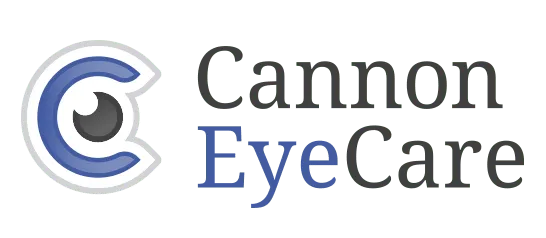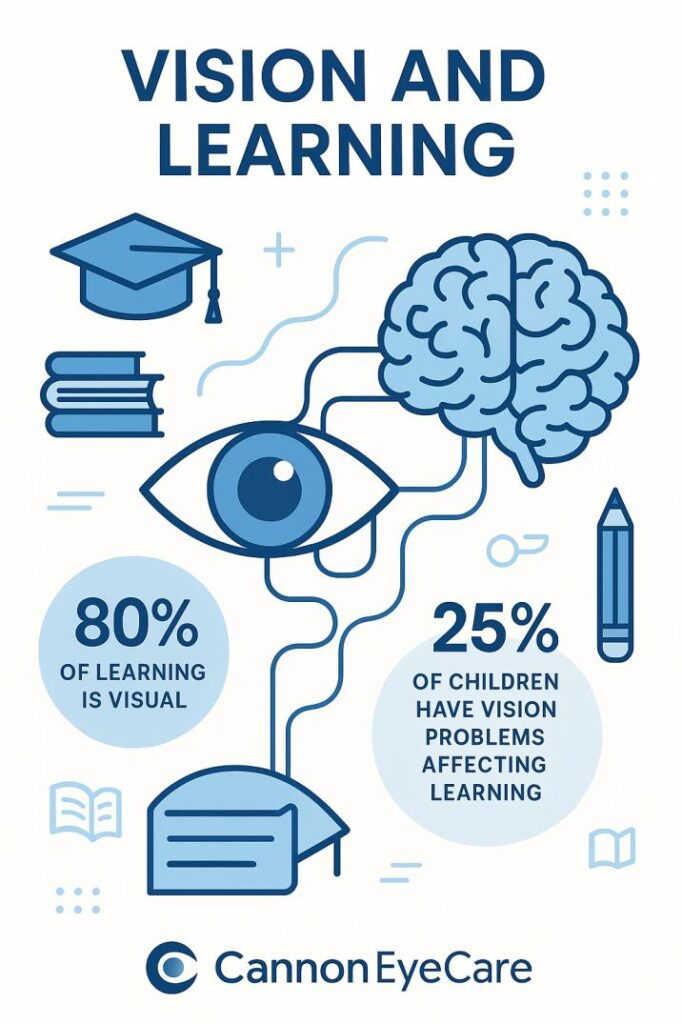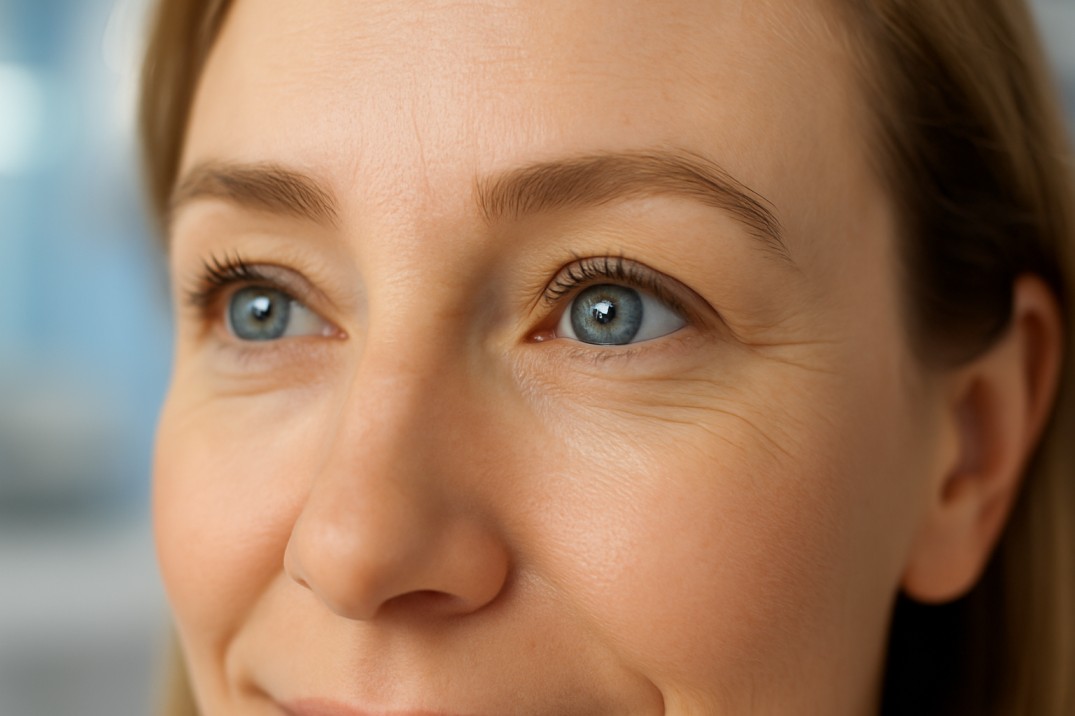Vision and Learning: What Parents Should Know
Bottom Line Up Front: Vision problems affect up to 25% of school-age children and can significantly impact academic performance. Early detection through comprehensive eye exams and proper vision correction can dramatically improve learning outcomes, reading scores, and classroom behavior.
Introduction: The Hidden Connection Between Vision and Learning
Picture this: your child sits in the back of the classroom, struggling to see the whiteboard. They squint, tilt their head, and eventually lose focus as the conversation continues. What might look like attention problems or learning difficulties could be undiagnosed vision issues affecting their ability to learn.
Rensistently shows that up to 80% of learning in school is presented visually, making clear vision essential for academic success. Studies have demonstrated that children who need vision correction show improved success in school after getting glasses, including significant improvements in reading and learning scores.
At Cannon EyeCare in Seattle, we understand how crucial good vision is for your child’s educational journey. Our Midwestern hospitality meets expert eye care to ensure every child can see everything they need to succeed in school and beyond.
Understanding Vision Problems: How Common Are Learning-Related Vision Issues in Students?
Alarming Statistics Every Parent Should Know
According to the American Optometric Association, 25% of all children (1 in 4 students) have a vision problem significant enough to impact their learning, and many of these issues remain undetected. Studies show that 60% of “problem learners” actually suffer from undetected or untreated vision problems.
Research reveals that up to 40% of students diagnosed with learning disabilities have uncorrected vision problems rather than true learning disabilities. This means thousands of children may be receiving unnecessary special education services when they simply need proper vision correction.
The COVID-19 Impact on Children’s Vision
The pandemic has intensified vision-related learning challenges. A comprehensive 2025 study found that Computer Vision Syndrome affects 69% of the population, with symptoms significantly increased due to remote learning and digital device usage. Parents in Seattle and across the country are noticing more eye strain, headaches, and focusing difficulties as children adapt to digital learning environments.
The Science: How Vision Problems Directly Impact Academic Performance
Reading and Comprehension Challenges
Vision problems can severely affect reading comprehension. Children with vision-related learning issues typically lose their place while reading, struggle to make sense of letters, and have difficulty understanding written material.
Key Reading Impacts Include:
- Slower reading speeds
- Poor text comprehension
- Difficulty tracking across lines
- Frequent loss of place on the page
- Avoidance of reading activities
Classroom Focus and Attention Issues
When children can’t see clearly, they become easily distracted and have difficulty focusing on schoolwork. This leads to what appears to be attention problems but is a vision-related learning difficulty.
Common Classroom Behaviors: Try concentrating during lessons
- Appearing disinterested or disruptive
- Avoiding tasks requiring visual focus
- Frequent complaints of headaches or eye strain
- Poor posture while reading or writing
Mathematical and Writing Skills
Vision problems don’t just affect reading. Children with poor vision may struggle with handwriting, seeing math problems clearly, and processing visual information needed for mathematical concepts.
Recognizing the Warning Signs: What Parents and Teachers Should Watch For
Academic Performance Indicators
Red flags in school performance:
- Reading below grade level
- Inconsistent academic performance
- Difficulty copying from the board
- Poor handwriting or spacing
- Avoiding homework or reading tasks
- Lower test scores despite effort
Physical and Behavioral Signs
According to optometry experts, key signs that vision may be impacting learning include frequent squinting, head tilting when trying to focus, eye rubbing, and complaints of double or blurry vision.
Physical symptoms to monitor:
- Squinting while reading or looking at the board
- Tilting the head when focusing
- Covering one eye while reading
- Holding books very close to the face
- Frequent eye rubbing or blinking
- Complaints of headaches after visual tasks
Behavioral Changes
Children with undiagnosed vision problems often develop poor self-esteem and may become frustrated with academic tasks, leading to behavioral issues that mask the underlying vision problem.
Types of Vision Problems That Affect Learning
Refractive Errors
Myopia (Nearsightedness) Myopia makes it difficult for children to see distant objects clearly, including text on classroom boards. This can cause children to lose focus and struggle to understand the teacher’s instructions.
Hyperopia (Farsightedness) can cause eye strain during close work like reading and writing, leading to fatigue and difficulty concentrating.
Astigmatism creates blurred or distorted vision at all distances, making it hard to distinguish letters and numbers clearly.
Binocular Vision Problems
Convergence Insufficiency. This condition affects the eyes’ ability to work together when looking at nearby objects, making reading and close work difficult and causing significant eye strain.
Strabismus (Eye Misalignment) Eye misalignment can lead to double vision or difficulty focusing on objects, causing children to struggle with reading, copying from the board, and visual-spatial tasks.
Visual Processing Issues
Beyond simple refractive errors, some children struggle with how their brains processes visual information. These learning-related vision problems can affect visual memory, visual discrimination, and visual-motor integration skills essential for academic success.
The Research: Scientific Evidence of Vision’s Impact on Learning
Recent 2024 Studies
A groundbreaking 2024 study published in Scientific Reports examined 1,126 elementary students and found statistically significant differences in academic achievement between children who passed versus failed complex vision tests, particularly among first-grade students.
Landmark Baltimore Study Results
The Baltimore Reading and Eye Disease Study, conducted by Johns Hopkins researchers, was the largest clinical study of vision’s impact on education ever conducted in the United States. Results showed sustained vision improvement and academic benefits when children received comprehensive eye care through school-based programs.
UCLA Vision to Learn Analysis
UCLA’s comprehensive analysis of the Vision to Learn program found that teachers reported glasses helped students become more engaged in the classroom, more confident about participating in class, and resulted in fewer classroom disruptions. UCLA researchers also found that 80% of classroom learning is visual, and over 20% of students have vision problems that can be identified by screening.
Stanford University Research on Test Score Improvements
Stanford University’s Rural Education Action Plan study found that over nine months, wearing glasses raises a nearsighted child’s test scores by an average of 14 points. This means that without proper vision correction, children are essentially losing an equivalent amount of academic progress.
Comprehensive Solutions: How Cannon EyeCare Addresses Vision Problems Affecting Learning
Why School Screenings Aren’t Enough
Traditional school vision screenings can miss up to 75% of children with vision problems. These basic screenings, such as the Snellen eye chart, detect only 20-30% of school vision problems. Of those students identified as having eye problems through basic screenings, 61% never follow up with proper eye care.
The Cannon EyeCare Approach to Vision Problems and Learning
At Cannon EyeCare, we provide comprehensive pediatric eye examinations that go far beyond basic vision screenings to address vision problems that affect learning. Our approach includes:
Thorough Assessment Components:
- Complete visual acuity testing at all distances
- Binocular vision evaluation
- Eye health examination with advanced diagnostic technology
- Assessment of visual processing skills
- Dry eye screening (increasingly important with digital device use)
- Discussion of your child’s specific visual demands
Child-Friendly Environment: Our Seattle clinics in University Village and Pike Place Market provide a welcoming atmosphere where children feel comfortable. We work with kids age 5 and older who know their letters, using age-appropriate testing methods.
What Makes Comprehensive Exams Essential
A comprehensive eye exam is the first step to determine if vision problems are contributing to learning difficulties. Simply correcting basic refractive errors like nearsightedness and astigmatism can solve many academic challenges quickly and easily.
Advanced Testing Capabilities:
- Retinal photography for early disease detection
- Specialized testing for learning-related vision problems
- Assessment of accommodation (focusing) and convergence abilities
- Evaluation of eye movement and tracking skills
How Cannon EyeCare Treats Vision Problems to Improve Learning
Immediate Academic Improvements
Studies consistently show that children who need vision correction have improved success in school after getting glasses, including significant lifts in learning and reading scores. Many students also improve their concentration in the classroom after receiving proper vision correction through Cannon EyeCare’s comprehensive treatment approach.
Real-World Success Stories
One documented case involved a 5th-grade student making C’s and D’s with disruptive classroom behavior. After vision screening, eye examination, and prescription glasses, disruptive behaviors stopped almost immediately, and grades improved to B’s within three months.
Treatment Options Available
Prescription Eyewear:
- Traditional glasses for full-time wear
- Specialized lenses for specific tasks
- Contact lenses for active children
- Blue light filtering for digital device use
Vision Therapy: For more complex vision problems, individualized vision therapy programs can address issues with eye coordination, focusing, and visual processing skills.
Ongoing Management: Regular follow-up care ensures prescriptions remain accurate as children grow and their visual needs change.
Creating a Learning-Friendly Environment for Children with Vision Problems
At Home Strategies
Optimize Study Spaces:
- Ensure adequate lighting for reading and homework
- Position computer screens at appropriate distances
- Take regular breaks from close work
- Encourage outdoor play to support eye development
Monitor Digital Device Use: Research shows that balancing children’s near work with outdoor time is one of the most effective strategies to delay myopia onset and slow its progression.
Working with Schools
Classroom Accommodations:
- Request seating closer to the board for children with vision issues
- Ensure adequate classroom lighting
- Communicate with teachers about your child’s vision needs
- Advocate for vision-friendly classroom practices
Educational Team Approach: The best outcomes occur through a team approach involving teachers, school psychologists, and eye care professionals who specialize in children’s vision problems and learning-related vision issues.
Why Cannon EyeCare is Seattle’s Leading Choice for Vision Problems Affecting Learning
Our Expertise in Pediatric Eye Care
As Seattle’s trusted vision experts, Drs. Mark and Miranda Cannon at Cannon EyeCare bring both professional expertise and genuine Midwestern care to every patient interaction. Our specializations include:
- Comprehensive pediatric eye exams using the latest diagnostic technology
- Myopia management to slow progression in nearsighted children
- Dry eye evaluation and treatment are increasingly important for digital natives
- Complex contact lens fittings for active children and teens
- Co-management for specialized procedures when needed
Convenient Seattle Locations
University Village: Our flagship Cannon EyeCare location offers comprehensive family eye care in a welcoming retail environment with convenient parking.
Pike Place Market: Our downtown Seattle Cannon EyeCare location provides easy access for urban families, just steps from public transportation.
Insurance and Accessibility
We accept major insurance plans including Kaiser Permanente PPO, Medicare, Premera, Regence, Lifewise, and Blue Cross/Blue Shield, making quality eye care accessible to Seattle families. We do not accept independent vision plans such as VSP, EyeMed, or Davis Vision due to contractual limitations.
Cannon EyeCare Pricing (2025):
- Comprehensive glasses exam: $225
- Eye exam with contact lens fitting: Approximately $345 (price varies based on complexity)
Prevention: Protecting Your Child’s Vision for Lifelong Learning
Early Detection is Key
The American Optometric Association recommends children have their first eye exam at six months, followed by exams at age three and annually once starting school. Early detection prevents long-term academic and behavioral challenges.
Ongoing Vision Health
Annual Eye Exams: Regular comprehensive eye exams ensure prescriptions stay current and eye health remains optimal throughout crucial development years.
Lifestyle Factors:
- Encourage outdoor activities
- Limit excessive screen time
- Maintain proper nutrition for eye health
- Protect your eyes from UV exposure with quality sunglasses
Supporting Academic Success
Experts confirm that 80% of what children learn in school is visual information, making good vision essential for students to reach their full academic potential.
Taking Action: Next Steps for Parents
When to Schedule an Eye Exam
Immediate consultation is recommended if your child shows:
- Declining academic performance
- Frequent complaints of headaches or eye strain
- Behavioral changes related to schoolwork
- Physical signs like squinting or eye rubbing
- Teacher concerns about classroom focus
What to Expect at Your Cannon EyeCare Appointment
Our comprehensive pediatric eye exams at Cannon EyeCare typically take about an hour and include:
- Detailed Vision History: Understanding your child’s visual challenges and academic concerns
- Complete Eye Health Assessment: Using advanced diagnostic equipment to examine all eye structures
- Comprehensive Vision Testing: Evaluating not just clarity but how well the eyes work together
- Personalized Treatment Plan: Tailored recommendations for your child’s specific needs
- Follow-up Care: Ensuring optimal results through continued monitoring
Scheduling Your Appointment
Ready to give your child the gift of clear vision and academic success? Contact Cannon EyeCare today:
- Online Booking: Schedule conveniently at your preferred location
- Phone Consultation: Speak directly with our knowledgeable team
- Insurance Verification: We’ll help confirm your coverage before your visit
Resources and Research Citations
This article is based on extensive research from leading medical institutions and peer-reviewed studies. Below are three key resources that support the information presented:
1. Stanford University Rural Education Action Plan Study
Source: Stanford Freeman Spogli Institute for International Studies
Link: https://fsi.stanford.edu/research/seeing_is_learning__project_impact
Key Finding: This landmark randomized controlled trial demonstrated that wearing glasses raises a nearsighted child’s test scores by an average of 14 points over nine months, providing concrete evidence of vision correction’s impact on academic performance.
2. UCLA Vision to Learn Impact Analysis
Source: UCLA Mattel Children’s Hospital Research
Link: https://visiontolearn.org/impact/ucla-study-impact-analysis-of-vision-to-learn/
Key Finding: Comprehensive analysis showing that 80% of classroom learning is visual, over 20% of students have identifiable vision problems, and teachers reported significant classroom engagement improvements after students received glasses.
3. Scientific Reports: Vision Performance and Academic Achievement Study
Source: Nature Scientific Reports (2024)
Link: https://www.nature.com/articles/s41598-024-56548-7
Key Finding: A Recent 2024 study of 1,126 elementary students found statistically significant correlations between complex vision test performance and academic achievement, particularly among first-grade students, supporting the critical connection between vision and learning.
Conclusion: Investing in Your Child’s Visual Future
Vision problems affecting learning are more common than most parents realize, but they’re also highly treatable when properly diagnosed. The difference between a struggling student and a successful one may be as simple as a pair of properly prescribed glasses or targeted vision therapy.
At Cannon EyeCare, we’re committed to ensuring every Seattle child has the clear, comfortable vision they need to succeed academically and beyond. Our comprehensive approach to treating vision problems and learning difficulties, combined with genuine care for each patient, makes us the trusted choice for families throughout the Seattle area.
Don’t let undiagnosed vision problems limit your child’s potential. Schedule a comprehensive eye exam with Cannon EyeCare today and discover how clear vision can transform your child’s learning experience.
FAQs
-
Vision problems can make it hard to read, write, or see the board clearly, leading to lower grades, missed assignments, and frustration in class




